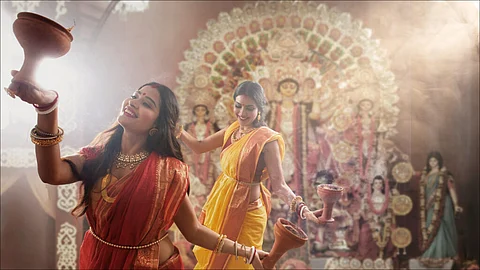
- Home
- Live Blog
- Breaking News
- Top Headlines
- Cities
- NE News
- Sentinel Media
- Sports
- Education
- Jobs

Ananya Gogoi
(ananyagogoi@gmail.com)
The five thousand-year-old Indian civilization and culture stands as a magnificent testament of spirituality, wisdom, and resilience, where divinity is not just revered but lived through daily practices and values. At the core of this ancient culture lies the remarkable essence of Sanatan Dharma, a way of life that fosters a deep and enduring connection between humanity and the divine. This connection is the very foundation on which Indian culture has built its values and ethics, forging a path of harmony between the material and the transcendent.
From the sacred hymns of the Vedas to the echoes of contemporary prayers, the reverence for deities has been the bedrock of this spiritual culture. One of the most exalted figures within this spiritual framework is Goddess Durga who epitomises the supreme power and energy that permeates the universe. As Mahamaya, the great illusion, Maa Durga represents the eternal struggle between good and evil, light and darkness.
Legend tells of a dire time when the gods, beleaguered by the tyranny of the demon Mahishasura, appealed to the divine triad of Brahma, Vishnu, and Shiva. From their collective strength emerged Goddess Durga. As the Puranas recount, Durga Devi was born from the womb of Menaka, the consort of Giriraj Himalaya, the Lord of the Mountains, making her the child of the mountains - a force as immovable and eternal as the towering peaks.
Revered by many names - Chandika, Kalika, Uma, Adyashakti, Mahamaya, Mahagauri, Katyayani, Sanatani, Ugrachanda, Chamunda, Jagaddhatri etc., Maa Durga’s divine manifestations showcase her myriad forms. From the fierce protector of the vulnerable to the compassionate mother, her incarnations tell the tale of resilience and hope. The glory of her nine forms, Navadurga, symbolise the goddess’ boundless energy in overcoming darkness and adversity.
Durga Maa’s divine role is not confined to mythological stories; it has been immortalised in some of India’s greatest epics. In the Virata Parva of the Mahabharata, the Pandavas prayed for her blessings during their arduous exile, illustrating her significance in their trials. As the scholar Banikanta Kakati observed, the full conception of Mahadevi, the supreme goddess, comes to life in the Devi Mahatmya section of the Markandeya Purana, but traces of her power can be found far earlier, in texts like the Mahabharata and the Harivamsha. In the Bhishma Parva (Chapter 23) of the Mahabharata, Arjuna, guided by Lord Krishna, extols the virtues of Durga Maa, invoking her through many names- Kumari, Kali, Kapali, Mahakali, Chandi, Katyayani, Karala, Vijaya, Kaushiki, Uma, and Kantavasini. In the Virata Parva (Chapter 6), Yudhishthira offers a stirring prayer to Durga, addressing her as the slayer of Mahishasura. Her divine presence is further illustrated in tales where Brahma invokes her to be rescued from the demons Madhu and Kaitabha, and where Lord Shiva, the God of Gods, calls upon her for salvation from the demon Tripurasura.
History, too, bears testimony to her profound role in the lives of monarchs and warriors. In the Satya Yuga, King Suratha, having suffered a grievous defeat, sought refuge in the ashram of sage Medhas. Heeding the sage’s wise counsel, he conducted the first-ever Durga Puja in spring, a celebration that came to be known as Vasanti Puja, which led to his triumphant reclamation of his kingdom. In the Treta Yuga, Lord Ramachandra, before his final battle with Ravana, performed Durga Puja during autumn, an occasion now known as Akal Bodhan - the untimely awakening of the goddess.
Goddess Durga is depicted with a ten-armed form, each arm bearing the strength of the various gods and goddesses by her side. To her right stands Lakshmi, the Goddess of prosperity, and Lord Ganesha, the remover of obstacles. On her left are Saraswati, the Goddess of knowledge, and Kartikeya, the valiant commander of the celestial army. This divine assembly reflects Durga Maa’s role as the unifying force that encompasses all aspects of life - prosperity, knowledge, power, and purity.
In the North-eastern region of India, particularly Assam, the worship of Goddess Durga finds a deep cultural resonance. The Kalika Purana, Yogini Tantra, and Markandeya Purana elaborate on the primordial form of Maa Durga worshipped in Kamrup. The Devi Mahatmya illustrates how Durga Devi and Goddess Lakshmi are two sides of the same divine force, representing the duality of creation- while Durga bestows protection and power, Lakshmi ensures prosperity and happiness. During times of adversity, Maa Durga assumes her fearsome form as Alakshmi, a stark reminder of the balance between creation and destruction.
The Puranas recount how Goddess Durga assisted Lord Vishnu as Yogmaya and Yognidra in slaying the demons Madhu and Kaitabha, thereby saving Brahma from their malevolent grasp. Subsequently, she took on the forms of Katyayani and Kaushiki to defeat Mahishasura and Shumbha-Nishumbha, liberating the oppressed deities from despair and tyranny.
The discovery of ancient ten-armed statues of Mahishamardini and four-armed Chamunda across Assam bears testament to the ancient tradition of Shakti worship in the region. This reverence blossomed during the reign of the Koch kings, as articulated in Madhav Kandali’s Ramayana. Pitambar Siddhanta Vagisa Bhattacharyya, a luminary in the court of Maharaja Naranarayan, wrote extensively on the Durgaotsav Koumudi, revealing that the tradition of creating clay idols of Durga Devi in Assam has historical roots that go back centuries.The Adyarsha Koumudi further elaborates on the rituals of installing the idol and invoking life into the clay representation.
Today, the resounding glory of Goddess Durga continues to inspire unwavering devotion among millions of worshippers across the globe. Her legacy transcends time, embodying the strength and resilience inherent in the heart of every Indian. Her story is one of boundless strength and divine wisdom, a heritage that not only honours the past but illuminates the path toward a brighter, more harmonious future.